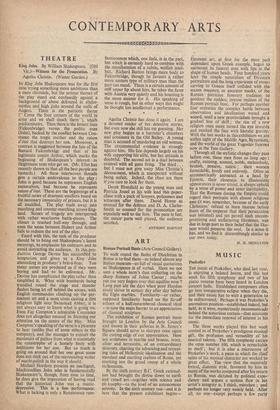ART
Roman Portrait Busts (Arts Council Gallery).
To walk round the Baths of Diocletian in Rome is to find them—as indeed almost any Italian museum—as full of visual quotations as Shakespeare is of verbal. Have we not seen a whole term's dust collecting on the sharp features of Julius Caesar ; maybe • run our very fingers over that aquiline nose ? Long past are the days when poor Haydon could shiver in ecstasy day after day before the Elgin marbles. Familiarity—or rather, supposed familiarity based on the far-off echoes of a half-remembered classical ideal —is now the main barrier to an appreciation of classical sculpture.
The exhibition of Roman portrait busts brought to London by the Arts Council and shown in their galleries in St. James's Square should serve to sharpen once again the cutting edge of our appreciation. Here are sculptures in marble and bronze, ivory, silver and terracotta, of an extraordinary diversity, charting the advancing and retreat- ing tides of Hellenistic idealisation and the mordant and startling realism of Rome, yet marking too the grand sweep of a whole m.11ennium.
By the sixth century B.C. Greek rational- ism had brought the divine down to earth and raised art—together with science and ph losophy—to the level of an autonomous activity. In the sixth century too—and it is here that the present exhibition begins—
Etruscan art, at first for the most part dependent upon Greek example, began to surmount its funeral urns with lips in the shape of human heads. Four hundred years later the simple naturalism of Etruscan portraiture and the long experience of stone- carving in Greece itself collided with the waxen imagines, or ancestor masks, of the Roman patrician funerary tradition to produce the sudden, intense realism of the Roman portrait bust. For perhaps another four centuries the complex battle between observation and idealisation waxed and waned, until a new provincialism brought a gradual loss of skill ; the rise of a new religion once more turned the eye inwards and masked the face with hieratic gravity. With the last works in this exhibition we are within sight of the Middle Ages, Byzantium, and the world of the great Yugoslav frescoes now at the Tate Gallery.
Through all the stylistic changes they pass before one, these men from so long ago : crafty, cunning, sensual, noble, melancholy, brutish, pensive, satiric • their women formidable, lovely and unlovely. Often as asymmetrically animated as a head by Epstein, their closeness to illusionistic appearances is never trivial, is always upheld by a sense of power, and inner inevitability. That the Romans during the Empire could regard their portraits with almost religious awe (it was, remember, because of the early Christians' refusal to burn incense before busts of the emperor that their persecution was initiated) and yet permit such uncom- promising and unflattering likenesses, was due in large part to their belief that the like- ness would preserve the soul. In a sense it has, and we find it discomfitingly similar to our own today.
M. H. MIDDLETON


































 Previous page
Previous page